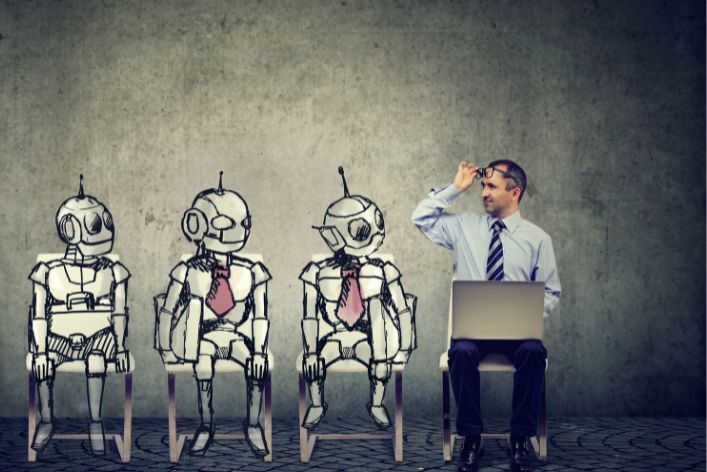There are many misunderstandings about what artificial intelligence and deep learning actually mean.
Artificial intelligence involves building intelligent machines.
Deep Learning is a branch of machine learning that trains a model using enormous amounts of data and sophisticated algorithms.
And machine learning is a subset of artificial intelligence that facilitates the development of AI-driven applications.
We compared and connected Machine learning and AI here.
Let’s explore the differences between artificial intelligence and deep learning, two phrases frequently used in the same sentence.
What is Artificial Intelligence?
AI integrates human intelligence into machines using a set of rules.
The term “artificial intelligence” combines “artificial” (created by humans) and “intelligence” (capacity for understanding).
Artificial intelligence studies how to teach computers to emulate human brain functions.
AI focuses on three main components (skills): learning, reasoning, and self-correction to achieve the highest efficiency feasible.
The majority of AI systems mimic natural intelligence to handle challenging issues.
Amazon Echo is a great illustration of an AI-driven product.
Smart speakers like the Amazon Echo use Alexa, Amazon’s artificial intelligence-powered virtual assistant.
Amazon Alexa verbally engages with you, plays music, sets alarms, and provides real-time updates.
Read: The Role of Artificial Intelligence in Speech Recognition Technology

What is Deep Learning (DL)?
Deep Learning, a branch of Machine Learning, uses Neural Networks to simulate human brain activity.
DL algorithms process information to find patterns and classify data accordingly.
Deep learning systems can use large amounts of both structured and unstructured data.
The fundamental idea behind them is artificial neural networks, which allow robots to make judgments.
It makes use of artificial neural networks that mimic human decision-making to address problems in the real world.
Deep learning may be expensive and needs a lot of data to train.
A learning algorithm must comprehend many parameters, often leading to numerous false-positive results.
A deep learning algorithm, for instance, may be taught to “learn” what a dog looks like.
Identifying minute features that distinguish a dog from a wolf or fox requires a large photo collection.
Read: Deep Learning for Beginners: A Comprehensive Guide
How Do They Work?
How Artificial Intelligence Works
Previously, Amazon Prime’s warehouses relied on workers for power.
However, this work is predictable, so artificially intelligent robots may streamline it.
Developers created robots using data on warehouse storage, order placement, and item picking and packing.
AI uses preexisting data and adapts its learnings to automate particular jobs.
AI is not particularly good at innovation and original thought.
Creativity, imagination, arts, physical skills, rhythm, and empathy are examples that don’t fit into core competencies.
In essence, AI’s goal is to raise success rates rather than accuracy.
When the robot transporting the yellow container filled with the goods you purchased becomes stuck, it cannot proceed.
This calls for originality and an all-encompassing strategy; it is a position for people.
Workers now assist robots in working in the newest Amazon distribution sites.
Put Your Tech Company on the Map!
Get featured on Nicholas Idoko’s Blog for just $50. Showcase your business, boost credibility, and reach a growing audience eager for tech solutions.
Publish NowHow Does Deep Learning Work?
The structure of the human brain is the direct inspiration for deep learning.
The brain consists of neurons that communicate to build connections and associations.
A specific set of neurons firing together or sequentially defines human thought.
These neurons also control numerous aspects of our intelligence and cognitive functions.
Deep learning simulates neurons and the layers of information seen in the brain to mimic this architecture.
Neural networks classify data independently, much like the brain recognizes patterns and interprets perceptions.
Neural networks can accomplish numerous tasks.
They mostly use comparisons between fresh data and previously collected and processed data in the model to extract insights from the data.
The way the human brain processes information is remarkably similar to this.
Because the system is autonomous and self-learning, it only needs a small amount of human intellect to keep getting better.
The model builds patterns by grouping data together, which it utilises to find new examples in the future.
The model’s data collection cluster includes any examples.
A typical deep learning model has numerous “layers” of data that the model has gathered.
The model processes and assesses data as it travels through different layers.
The majority of deep learning systems use structures called artificial neural networks (ANNs).
As their name suggests, ANNs are deep learning systems with numerous connected individual nodes.
These neural networks resemble those in the human brain.
Numerous real-world applications, like natural language processing, picture restoration, and fraud detection, use deep learning.
Read: The 5 Major Branches of Natural Language Processing

What is the Difference between Artificial Intelligence, Machine Learning and Deep Learning?
They are nested inside of one another, which is their fundamental distinction.
Research disciplines frequently cross across and have an impact on one another.
In a nutshell, it might be said that the phrase “artificial intelligence” (AI) covers ideas related to machine learning and deep learning.
Artificial intelligence refers to any machine that displays intelligence in any way.
There is a need to distinguish between the two because many systems that demonstrate AI do not necessarily exhibit machine learning processes.
Machine learning is only used by a small portion of AI apps that display artificial intelligence.
When AI is used to train a model to provide more accurate results from a vast data set, this process is known as machine learning.
Since deep learning directly imitates the architecture of the human brain to learn from data, it is an even more specialised form of machine learning.
Artificial and convolutional neural networks are digital representations of the way the brain is organised, simulating the connections between neurons and their patterns.
The machine learning subfields of deep learning and neural networks primarily use this type of learning.
All deep learning approaches are machine learning, but not all ML models employ them, which is analogous to the link between ML and AI.
As a result, the overall framework can be considered artificial intelligence that incorporates machine learning and deep learning.
Read: AI Chatbots: How Natural Language Processing (NLP) Works
Conclusion
In conclusion, while artificial intelligence, machine learning, and deep learning are interconnected, they serve distinct purposes within technology.
AI aims to emulate human intelligence, encompassing a wide array of applications.
Machine learning, as a subset of AI, focuses on using data to train models and improve accuracy over time.
Put Your Tech Company on the Map!
Get featured on Nicholas Idoko’s Blog for just $50. Showcase your business, boost credibility, and reach a growing audience eager for tech solutions.
Publish NowDeep learning, a specialized branch of machine learning, mimics the brain’s neural networks to analyze vast amounts of data.
Understanding their differences and relationships is crucial as we continue to integrate these technologies into our daily lives.
Each plays a vital role in advancing the capabilities of intelligent systems.
Before You Go…
Hey, thank you for reading this blog post to the end. I hope it was helpful. Let me tell you a little bit about Nicholas Idoko Technologies.
We help businesses and companies build an online presence by developing web, mobile, desktop, and blockchain applications.
We also help aspiring software developers and programmers learn the skills they need to have a successful career.
Take your first step to becoming a programming expert by joining our Learn To Code academy today!
Be sure to contact us if you need more information or have any questions! We are readily available.
[E-Books for Sale]
1,500 AI Applications for Next-Level Growth: Unleash the Potential for Wealth and Innovation
$5.38 • 1,500 AI Applications • 228 pages
Are you ready to tap into the power of Artificial Intelligence without the tech jargon and endless guesswork? This definitive e-book unlocks 1,500 real-world AI strategies that can help you.
See All 1,500 AI Applications of this E-Book
750 Lucrative Business Ideas: Your Ultimate Guide to Thriving in the U.S. Market
$49 • 750 Business Ideas • 109 pages
Unlock 750 profitable business ideas to transform your future. Discover the ultimate guide for aspiring entrepreneurs today!
See All 750 Business Ideas of this E-Book
500 Cutting-Edge Tech Startup Ideas for 2024 & 2025: Innovate, Create, Dominate
$19.99 • 500 Tech Startup Ideas • 62 pages
You will get inspired with 500 innovative tech startup ideas for 2024 and 2025, complete with concise descriptions to help you kickstart your entrepreneurial journey in AI, Blockchain, IoT, Fintech, and AR/VR.
We Design & Develop Websites, Android & iOS Apps
Looking to transform your digital presence? We specialize in creating stunning websites and powerful mobile apps for Android and iOS. Let us bring your vision to life with innovative, tailored solutions!
Get Started Today



